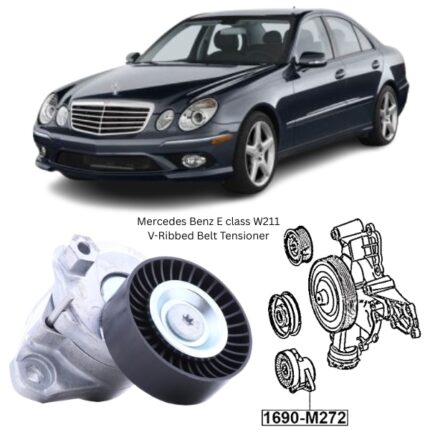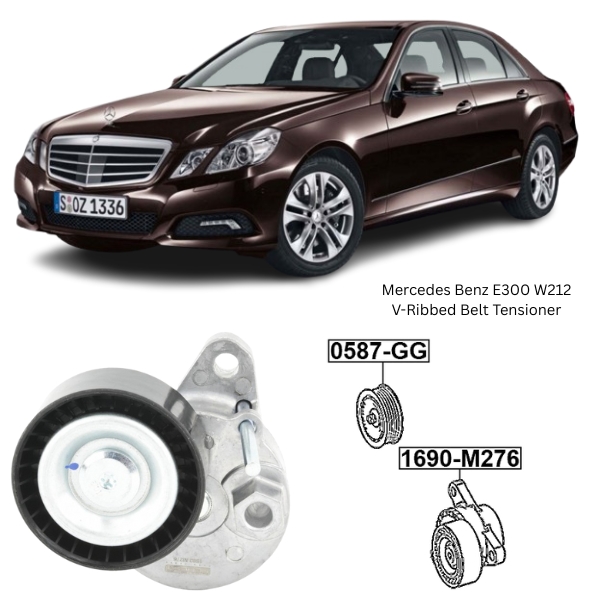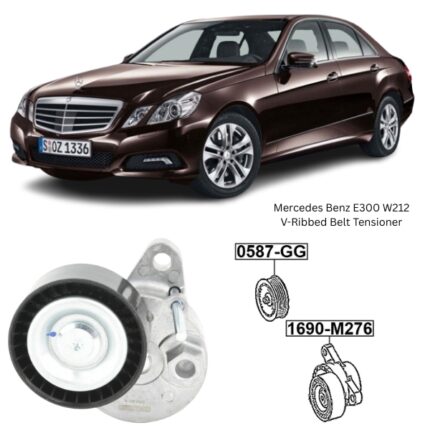Get Mercedes Benz E300 W212 V-Ribbed Belt Tensioner 1690-M276 in Kenya
At its core, the V-ribbed belt tensioner ensures that the serpentine belt remains under appropriate tension during engine operation. This is essential for the transmission of torque from the engine’s crankshaft to the various engine accessories. Without proper tension, the belt may slip, squeal, or even detach, leading to accessory failure, reduced engine efficiency, and potential safety concerns.
The tensioner dynamically adapts to belt fluctuations caused by thermal expansion, vibration, belt elongation, or pulley misalignment. It does this either through a mechanical spring mechanism or a hydraulic damping system, or in many cases, a combination of both. This adaptability allows the belt to maintain consistent grip and alignment throughout a wide range of operating conditions.
2. Key Components of a V-Ribbed Belt Tensioner
A typical V-ribbed belt tensioner is made up of several key components:
-
Tensioner Arm: A lever-like arm that holds the tensioner pulley. It pivots to apply pressure to the belt.
-
Tensioner Pulley: A smooth or ribbed pulley that the serpentine belt runs over. It allows for smooth rotation and guides the belt.
-
Spring Mechanism: Provides the mechanical force that presses the tensioner arm against the belt.
-
Damping Mechanism: Absorbs vibrations and fluctuations to prevent oscillation and belt flutter.
-
Bearing Assembly: Located within the pulley to ensure smooth, low-friction rotation.
-
Mounting Bracket: Connects the tensioner to the engine block or timing cover, holding the system in position.
The exact configuration may vary depending on the engine design, but these elements are fundamental to nearly all types of belt tensioners.
3. Types of V-Ribbed Belt Tensioners
There are three main types of belt tensioners used in modern automotive applications:
a) Automatic (Spring-Loaded) Tensioners
These are the most common in current engine designs. They use a coil spring inside the housing that applies consistent pressure against the tensioner arm. They self-adjust to maintain the correct belt tension throughout the belt’s service life. Benefits include reduced maintenance and consistent performance.
b) Hydraulic Tensioners
Instead of or in addition to a spring, hydraulic tensioners utilize pressurized fluid and a piston to maintain belt tension. These are more often used in timing belt systems but can also appear in serpentine systems. They are excellent at damping high-frequency vibrations and providing precise tension control.
c) Manual Tensioners
Manual tensioners require the technician to adjust the belt tension during installation and at regular maintenance intervals. Though less common in modern vehicles, they can still be found in some older models or heavy-duty applications. They offer simplicity but demand regular attention.
4. Material and Construction
V-ribbed belt tensioners are built to withstand extreme thermal and mechanical stress. Typical materials used include:
-
Pulley: Often made from high-strength plastic (composite polyamide) or steel. Plastic pulleys are lightweight and resistant to corrosion, while steel pulleys are highly durable.
-
Tensioner Arm & Bracket: Usually made of die-cast aluminum or steel for strength and weight savings.
-
Bearings: Precision-engineered with steel balls and races, sealed to prevent dust, water, or grease leakage.
-
Spring: Tempered steel for longevity and fatigue resistance.
The entire assembly must endure rapid temperature changes, engine vibrations, and mechanical shocks without deforming, seizing, or deteriorating prematurely.
5. Common Symptoms of a Failing Tensioner
A malfunctioning V-ribbed belt tensioner can cause significant engine issues. Some signs of failure include:
-
Squealing or Chirping Noises: Caused by belt slippage due to insufficient tension.
-
Vibrating Belt: Visible belt fluttering often indicates poor damping or worn tensioner components.
-
Accessory Failure: Alternator not charging, power steering becoming heavy, or A/C not cooling—all may result from a loose or misaligned belt.
-
Cracks or Wear on Belt: Uneven tension or a misaligned pulley can cause premature belt wear or cracking.
-
Visible Misalignment: A bent or wobbling pulley may indicate a worn-out bearing or arm.
Ignoring these signs can lead to more severe problems, including complete belt failure and loss of multiple engine systems.
6. Installation and Maintenance
Installing a V-ribbed belt tensioner generally involves the following steps:
-
Release Belt Tension: Using a wrench or special tool, rotate the tensioner arm to release tension and remove the belt.
-
Remove Old Tensioner: Unbolt the tensioner from the mounting bracket.
-
Install New Tensioner: Secure the new unit and ensure correct torque specifications are met.
-
Route the Belt: Follow the correct serpentine belt routing diagram for your engine.
-
Apply Tension: Rotate the tensioner again to fit the belt, then slowly release to apply tension.
It’s also advisable to inspect the belt for wear and replace it if necessary. Tensioners and belts often have similar service lifespans and are best replaced together to ensure optimal performance.
7. Lifespan and Replacement Intervals
On average, a V-ribbed belt tensioner lasts between 80,000 to 120,000 kilometers, but this varies depending on driving conditions, engine load, and maintenance habits. Factors such as frequent idling, harsh climates, or towing can accelerate wear. Many manufacturers recommend inspecting the belt tensioner at every major service interval or whenever the serpentine belt is replaced.
Regular inspection involves:
-
Checking pulley condition and free spin
-
Listening for bearing noise
-
Observing belt alignment and movement
-
Monitoring tension and deflection during engine operation
8. Importance in the Engine Ecosystem
The V-ribbed belt tensioner is not just a passive component—it directly affects the lifespan of the serpentine belt and the performance of the engine’s accessory systems. A properly functioning tensioner ensures:
-
Consistent Electrical Output: By keeping the alternator spinning at the correct speed.
-
Responsive Steering: By maintaining constant pressure on the power steering pump.
-
Comfortable Cabin Climate: By ensuring smooth operation of the A/C compressor.
-
Effective Cooling: By driving the water pump (in systems where it’s belt-driven).
Failure to maintain this part can lead to cascading mechanical failures and unexpected breakdowns.
Follow us on Facebook for more parts.





Reviews
Clear filtersThere are no reviews yet.